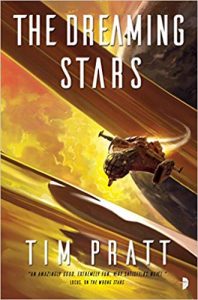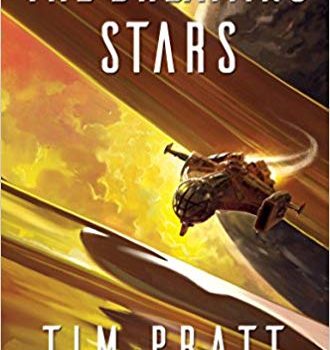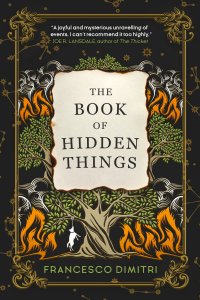Liz Bourke Reviews The Dreaming Stars by Tim Pratt
 The Dreaming Stars, Tim Pratt (Angry Robot 978-0857667670, $7.99, 384pp, pb) September 2018. Cover by Paul Scott Canavan.
The Dreaming Stars, Tim Pratt (Angry Robot 978-0857667670, $7.99, 384pp, pb) September 2018. Cover by Paul Scott Canavan.
The theme of this month, for me, is science fiction that leaves me gleeful and delighted by how much it’s pandering to my taste for low adventure and high fun. Tim Pratt’s The Dreaming Stars is delightful. It follows The Wrong Stars, the first novel in his Axiom series. The Wrong Stars was a brilliantly pulpish space opera romp, filled with compelling characters, weird alien tech, great banter, and more explosions than you could shake a stick at. It was good enough that I’ve been waiting impatiently for the sequel ever since. It’s a piece of great good fortune, then, that The Dreaming Stars is every bit as much fun as its predecessor.
Callie and the crew of the White Raven have been dead – as far as the rest of the universe is concerned – for several months, after stumbling across ancient Axiom technology and surviving the attempts of the Axiom’s servants – a secret cult within a secret cult within the ranks of the alien race known as the Liars – to destroy them and their knowledge. Hiding out on an asteroid that once served as a pirate base isn’t very entertaining, and Callie’s bored. When their Liar ally Lantern informs them it’s safe to come out of hiding simultaneously with Callie learning her ex-husband Michael is holding a memorial service for her, the temptation to show up at her own funeral is irresistible.
Lantern also asks for help from Callie and her crew. A cult base near the human-settled Taliesen system has stopped communicating with the rest of Lantern’s people. Lantern – newly elevated to the cult-within-a-cult, and determined to oppose their Axiom-serving goals – wants to make sure it’s not because of the Axiom.
Turns out that Lantern’s people aren’t the only ones to lose contact. Michael’s family corporation has interests on Taliesen, and, out in the asteroid belt, several surveyors and explorer-types have gone missing without a trace. Callie talks Michael into having his company hire her crew to go and check it out and – if they can – sort out the problem: they may have dedicated themselves to quietly fighting the Axiom’s plan for the universe while keeping knowledge of the Axiom secret, but that doesn’t mean they don’t need to get paid.
At the very edges of the Taliesen system, they discover an Axiom installation. The installation has sent out a cloud of self-replicating nanobots that consume everything in their path and transmit energy back home for an unknown purpose. In order to save the Taliesen system’s inhabited planet, Callie and her people are going to have to break into another Axiom installation and find the off switch – preferably without dying or being horribly mangled in the process.
Callie’s crew comprises Callie herself; Elena, a scientist and time refugee (stranded in cryosleep for a few hundred years, whose rediscovery kicked off the events of The Wrong Stars) who has become Callie’s lover; XO and chief medical officer Stephen, who’s struggling with the loss of his entire religious and most of his personal community during the course of The Wrong Stars; engineer Ashok; pilot and navigator duo Drake and Janice; and the AI Michael (“Shall”), based on the personality template of Callie’s ex. Along for the ride is initially-unconscious Sebastian, Elena’s fellow time refugee, who – thanks to Axiom brain implants – turned into a megalomaniac bent on conquering the universe, and whose recovery is uncertain. Though Elena is determined that he can be cured, many attempts to bring him out of his coma have resulted in evidence of his willingness to murder everyone else in order to get his own way. When it comes to shutting off the Axiom installation, though, his knowledge may be the key to success – if he can be trusted.
Callie, Elena, and Stephen are the primary viewpoint characters, and they’re all immensely appealing in their own ways. Callie’s not a very introspective character, but she’s very effective, and Pratt writes her with a dry sense of humour. Elena, on the other hand, is rather more introspective – and also much more open to the wonder of the universe, especially since for her, so much of it is new. (Their relationship is quite touching in its own way, especially since both of them are figuring out how it works and actually talking to each other about it.) And Stephen – Stephen’s doing his best to find a reason to keep living, it seems, although he doesn’t feel that the role of XO and ship’s doctor suits him as well as it used to.
The Dreaming Stars is fast and tense, with excellent dialogue, funny banter (much of it either graveyard humour or concerned with how much Callie and Elena are into each other), and characters who feel like real people. It has the atmosphere of pulp space opera, and a gleeful approach to the big ideas (and the big furniture) of science fiction. I really enjoyed it, and I hope Pratt has the opportunity to write many more novels in this setting.
Liz Bourke is a cranky queer person who reads books. She holds a Ph.D in Classics from Trinity College, Dublin. Her first book, Sleeping With Monsters, a collection of reviews and criticism, is out now from Aqueduct Press. Find her at her blog, her Patreon, or Twitter. She supports the work of the Irish Refugee Council and the Abortion Rights Campaign.
This review and more like it in the September 2018 issue of Locus.
 While you are here, please take a moment to support Locus with a one-time or recurring donation. We rely on reader donations to keep the magazine and site going, and would like to keep the site paywall free, but WE NEED YOUR FINANCIAL SUPPORT to continue quality coverage of the science fiction and fantasy field.
While you are here, please take a moment to support Locus with a one-time or recurring donation. We rely on reader donations to keep the magazine and site going, and would like to keep the site paywall free, but WE NEED YOUR FINANCIAL SUPPORT to continue quality coverage of the science fiction and fantasy field.







